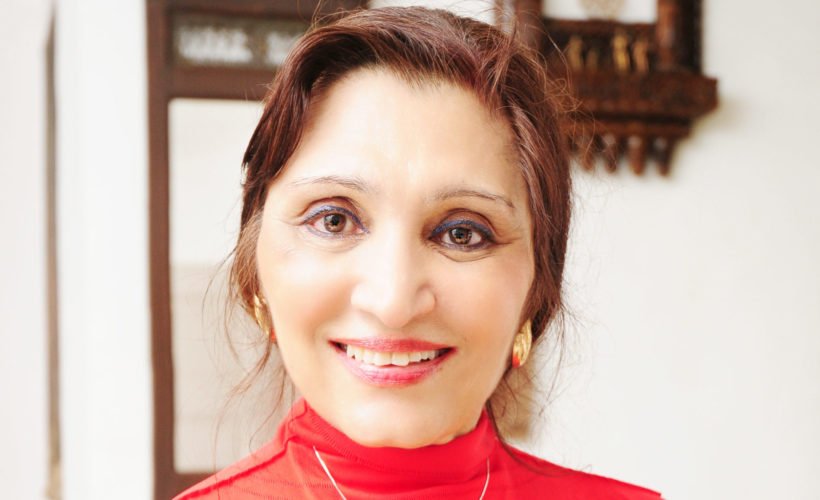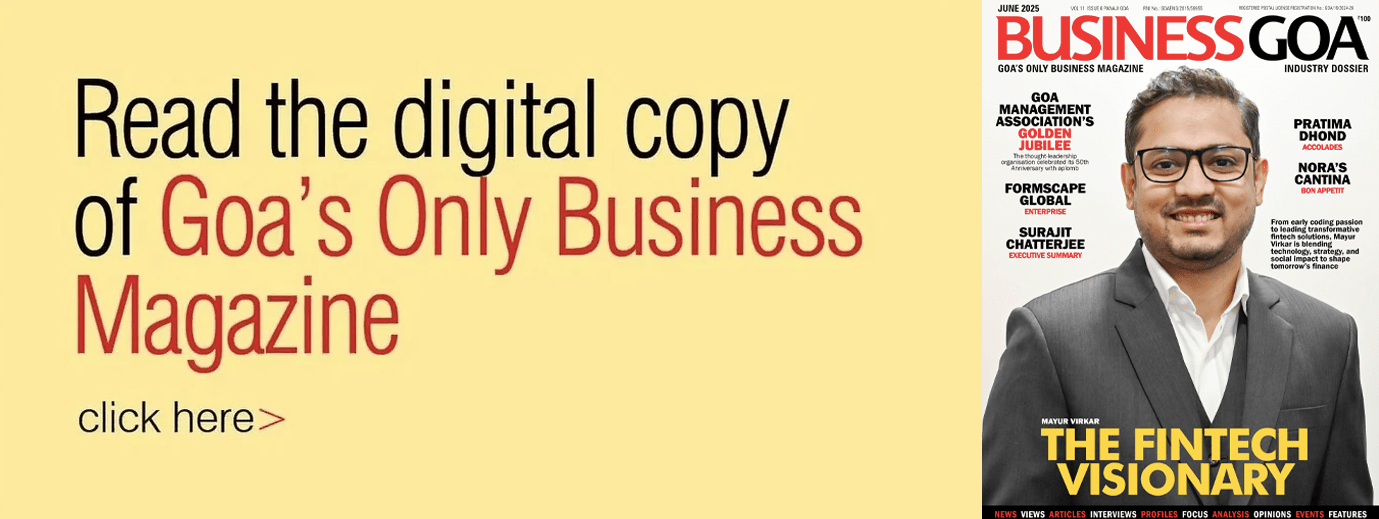
Sathya Saran shares her opinions on fashion journalism, writing for women and what makes people truly beautiful
In conversation with ANNA FERNANDES
Straddling the worlds of literature and journalism with equal zeal, Sathya Saran has an illustrious portfolio to her name. A pioneer of fashion journalism in India, she is best known for her role as editor of Femina and DNA Me. She is also an author, a columnist and a professor at NIFT, Mumbai.
In a successful integration of leadership skills and thought empowerment through a Master Class ‘Confidence is the key to Success’, recently held at the Goa Chamber of Commerce & Industry, Sathya launched her book ‘How to Look like Miss India’.
In conversation with Business Goa, Sathya Saran gives us a look into her journey as a journalist and spills the secrets on what makes the perfect Miss India.
Did you always harbour an interest in writing?
Yes. Ever since I can remember, I always loved to write. I wrote what I thought was a novel when I was in Class 7. It was called The Mystery of the Fingerprints. I scribbled it in my notebook that was around 25 pages. It was a mystery novel, a whodunnit. And, like all teens, I also wrote the usual poetry.
You are the pioneer of fashion journalism in the country; how did you venture into that space and genre?
I ventured into the women’s magazine Femina in 1992, when I took over as editor. At that point, the NIFT had just been established, designers had just come out, so naturally, we started tracking them. And then what came to be known as the fashion industry started picking up. Fashion became an ingredient of the magazine; later, beauty became an ingredient of the magazine. But it was not a fashion magazine like Elle or Vogue. It was a women’s magazine.
What is it like writing solely for women?
In the beginning, I felt, “What am I doing writing for a woman’s magazine? I want to be in a newspaper.” But as I went along I realised that my writing evoked a response. Unlike in a newspaper where you don’t know who reads it or who cares. While writing for a women’s magazine, I started getting a response. People started writing back, calling up and expressing their opinions. And I realised I was playing a role that was very important.
Would you say your writing played a role in empowering women?
Absolutely. Femina, at one point, was considered as a friend, philosopher and guide to women. And that was very, very gratifying. When I got on board at Femina, women were at crossroads, in the process of changing, not knowing which way to turn, and Femina was, for them, a lighthouse.
What are some of the highlights that you’ve experienced over the course of your career?
Oh, there are many highlights. I think when I wrote a good story, and I got a huge response. Other than that, the ability to reach out to women of all interests, whether it was travelling, fashion, food and so on. In addition, the fact that I was able to create the idea of food-styling in magazines, a concept that was unheard of in India before. It was something that I brought to the table. And I learnt on the job. Working with freelance photographers, we created these lovely pages, which today everyone takes for granted. And ditto with fashion. There was no fashion journalism before. There was no blueprint on how to write about fashion. So, one had to learn on the job, so these are highlights because, in the process, I grew as a person. Being in a magazine was very exciting. Every day was different, you never knew what the day would bring. Of course, there were times when things got tough, but it was never such that I wanted to give up.
How has fashion journalism and the fashion industry evolved over the years?
It hasn’t. Because, unfortunately, a lot of fashion journalism is still very PR-oriented. Nobody really wants to deconstruct fashion and explain it. I teach Fashion Journalism and Communication at NIFT. And I keep telling my students, you are not going to write about the showstopper at a fashion show, you’re not going to write about the designer parties – you are going to write about what the connection is all about: the styling, the fabric, the surface ornamentation, the decoration, the cut, the silhouette. There are magazines that do this, but by and large, the deconstruction of fashion is not very present. When you go to Lakme Fashion Week, Wills India Lifestyle Fashion Week, or FDCI Fashion Week, the journalists there, are in hundreds. But the real fashion journalists among them are barely a handful. With regard to the fashion industry, we are still in the crux of an evolution, which means we still have to shake off the foreign influence, not copy, not be inspired by, and find our own voice as a country which has amazing textiles, amazing embroidery, amazing work with gold thread and, finally, to exploit these and yet make them contemporary.
Tell us about your book ‘How To Look Like Miss India’?
The book is an insightful peep into what makes a Miss India look the way she does. I have put in my own experiences with the Miss India contest, and the experiences of a variety of women that I have come across – from beauty contestants to bank officials to high-level achievers to the woman selling khaftans. I have also interviewed all the experts who have worked with the Miss India contest and each of them has a chapter.
You have Dr Jamuna Pai talking about skincare, Dr Nirmala Shetty who is a naturopath talking about good hair and natural remedies for acne and dark circles. You have Wendell Rodricks talking about clothes and how to maximise your look through clothes, and different inputs from other experts. Other than that, there are some interesting pictures in the book that have never been seen before. Lots of different anecdotes, a lot of little advice tips from Sushmita Sen, Priyanka Chopra – all of us have contributed to it in some way or the other.
How important is it to be beautiful in society?
Everybody likes beautiful things, faces, children, anything that is beautiful attracts, but what we try to do, or what I am trying to do through this book is say that beauty is not enough, beauty fades, beauty makes you insecure, beauty makes you vain in the beginning but insecure later, but if you are truly beautiful and a good person, people will be attracted to you even when you are 90 years old.
What are some of these aspects that make one truly beautiful?
Confidence is key. Being confident, being well turned out, being knowledgeable, being able to hold a conversation, being able to meet people in the eye – a lot of people don’t feel secure enough to be able to do that. The book tackles the issues of self-image, confidence, which are important to look and feel good.
So, it’s about empowerment rather than just superficial beauty?
Exactly.
How do you think women can empower themselves, and be truly beautiful?
By just being sure of who they are. If you are confident about your place in your life, you have to learn not to care what others think. It took me really long to understand, but if you don’t care about what others think, you’ll be fine.
What is your take on the unrealistic beauty standards perpetuated by the media, that women everywhere are subject to?
Women, today, fall prey to advertising. If you’re fair they say, look dark and tan, and if you’re dark and tan, they say look fair. If you’re fat they say look thin, if you’re thin they say look thinner. It’s always been the case.
Every fairy-tale has a beautiful princess and a handsome prince. But I think, today, people are more aware of what body shaming is, understanding what unrealistic demands are being made on them and they are happier with who they are. That is something that I deal with in my book, how to make the most of what you have. If you have curly hair, don’t straighten it, if you have straight hair don’t put it into curlers.
What would be your advice to young people, to young writers?
Read more. That is my mantra. Read more, so that you know more. So you are able to grasp more of what is happening around you. Don’t live in a frog’s well, staring at your mobile devices. And to writers, again, I’d say: read more. Understand styles and try to develop your own style. You develop your own style when you develop your voice. And when you know what you want to say, say it with passion and conviction. And then it doesn’t matter whether you’re writing fiction or non-fiction, an essay or a boring government report, you can still make it interesting if you are passionate.
Were there any challenges that you had to overcome over the course of your career?
When I first started my career in Nagpur, I worked at a newspaper. And when it closed down, I moved to a rival newspaper. There I encountered a bit of this anti-woman sentiment. I was assigned all the soft stories. So, I started freelancing – writing for Eve’s Weekly and Femina. And, that led me to win an award.
When I won the award, I started writing regularly for Femina. When I wanted to get out of Nagpur, I picked up the phone and asked if there was a job opening at Femina. It’s all about following your heart and finding a way out of a tough situation.
What would you say is the belief system guiding all your pursuits?
Believe in yourself and do whatever you do with all your heart





